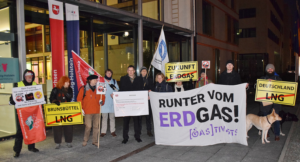“Gassy” Germany Beats “Green” Germany

Despite its “green” image, Germany remains the biggest gas consumer in Europe. Using almost 92 billion cubic metres (bcm) of fossil gas in 2017, gas accounted for 24 percent in Germany’s primary energy consumption. And the so-called “Climate Chancellor”, Angela Merkel, recently announced in Davos that the targeted coal phase-out will further increase Germany’s need for gas.
Because of its comprehensive cross-border pipeline infrastructure and its central location, Germany has become the main gas transit hub in Europe, with significant amounts of gas from Russia and Norway transiting the country for delivery to other markets: With a gas import capacity of 54 bcm per year from Norway (via three pipelines), 208 bcm per year from Russia (via 3 pipelines: North Stream 1, Yamal and the Ukraine pipeline system), and some 25 bcm per year from the Netherlands (via four main pipelines and interconnection points), and gas storage capacities of 24.6 bcm (via 51 gas storage facilities), Germany can import and store more than three times more gas than it consumes. According to the German Economy Ministry, Germany’s gas storage facilities are the fourth largest in the world and the largest in Europe.
With the existing Nord Stream pipeline, Gazprom is able to bring Russian gas directly to Germany through the Baltic Sea, allowing Moscow to bypass European transit countries such as Poland, Belarus, and crisis-hit Ukraine. Germany and Gazprom are now heavily pushing in favour of the construction of a second pipeline, Nord Stream II, which would double the current Russian gas influx capacity, from 55 to 110 bcm per year.
But instead of stopping the project or starting a debate about the real need for gas in Germany, the country is additionally investing public money in counter-projects of Nord Stream 2 such as the Southern Gas Corridor. It also welcomes the propopals for the construction of the first LNG terminal in Germany, and provides a budget for fracked gas LNG import terminals.
Proposed LNG Terminals For Germany
The most far advanced candidate is Brunsbüttel, in the federal state of Schleswig-Holstein. According to Brunsbuettel Ports, the gas could come from the US and could be used on-site, for example, by Yara, one of the so-called “Exxons of agriculture,” to make fertilizer. German energy company RWE has signed a capacity contract with investor German LNG and reached a cooperation agreement with world leading LNG buyer Tokyo Gas. The way forward for RWE is clear: the German utility wants to buy more US LNG as Trump promotes gas riches in Europe.
The biggest competitor of Brunsbüttel is Stade, located in the neighbouring federal state of Lower Saxony. This location is favoured by petrochemical giant and fracking proppants provider Dow Chemical, which wants to use the gas for its energy intensive facilities and as a direct feedstock for the production of plastics and petrochemicals. The Dow Chemical site alone consumes one percent of Germany’s eletricity production.
Bowing down to pressure from the Trump administration, Germany’s Economy Minister, Peter Altmaier, has invited US LNG export companies to a conference in Berlin on February 12th.
Opposition on The Rise
Despite their otherwise expressed support for the shale gas fracking ban in Germany, German politicians at both the national and federal state levels are all of a sudden overly excited about importing fracked US LNG for petrochemicals and fertilizers.
But people have definitely enough of this ongoing hypocrisy and opposition is growing throughout the country.
Food & Water Europe found in October the support of over 20 environmental NGOs and grassroots groups for a first official statement against the proposed LNG terminal at Brunsbüttel. A first expert discussion organized by the Greens gave us the opportunity to present our arguments on November 19 in the parliament of Schleswig-Holstein in Kiel and forced the investor to open up a public dialogue with several events to come in February 2019.
In the early hours of January 31, we surprised politicians and industry officials (who met for a so-called parliamentary breakfast to celebrate themselves and the proposed LNG terminal at Brunsbüttel) with a protest action in the front of the permanent representation of the federal state of Schleswig-Holstein in Berlin.
Our unexpected protest action was picked up by the local media. We also made use of the presence of the prime minister of Schleswig-Holstein and handed out a petition against the proposed LNG terminals in Germany – signed by over 67,000 people by the end of January.
One thing is now clear for everyone involved: we are ready for this evolving fight.
Pictures of the action can be found here: https://www.flickr.com/photos/uwehiksch/sets/72157702938218842
Read our factsheet on LNG (in German).


